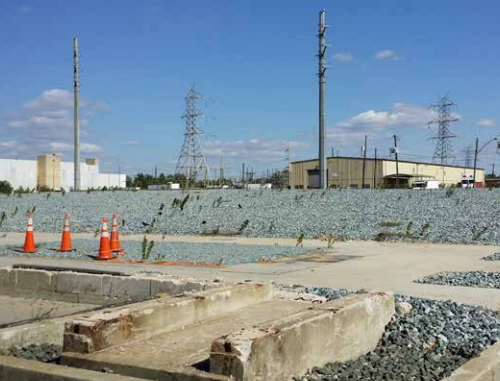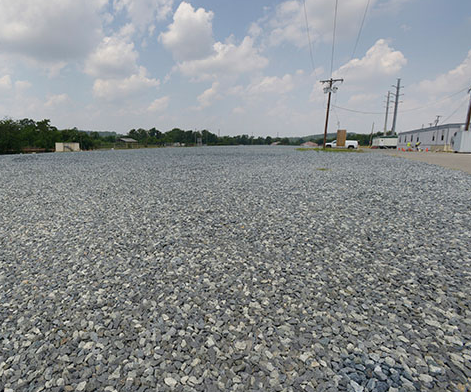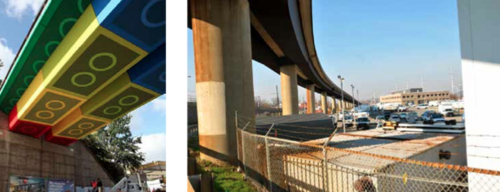An old power plant in DC’s Ward 7 is ripe for redevelopment. Let’s not make it a trash and recycling plant.
Between the Anacostia River and I-295, a defunct power plant stretches along the north side of Benning Road. A plan for how to put the space to use just came out, and while some of the ideas could bring jobs to the community, others threaten to perpetuate a history of communities east of the Anacostia getting the short end of the stick.

Pepco’s Benning Road site is desolate now, but it could turn into something great. Image from the DC Office of Planning.
The Benning Service Center is a 77 acre industrial campus located on the eastern bank of the Anacostia River. In 2015 Pepco demolished its 100-year-old oil fired plant on the site and after decades of community advocacy led by leaders such as George Gurley. Following the demolition Pepco began a DC Department of Energy and Environment supervised cleanup of PCBs and other contaminants in the soil and neighboring Anacostia River.
In the last decade the Kenilworth-Parkside community has seen the construction of 400+ homes, two schools, and significant reinvestment in the historic Mayfair Mansions Apartments. In the next decade the community is anticipating the construction of 1300 more homes, retail, an education campus and office space. Nearby Minnesota Avenue has seen the construction of Park 7 Apartments and the District Department of Employment Services building. To the south, River Terrace is increasingly drawing the attention of developers looking to capitalize on the extension of DC’s streetcar.
Given the considerable investment going into the community, the Pepco site is looking increasingly anachronistic in its current state, but its proximity to Metro, the streetcar, and I-295 give it incredible potential. With the right changes, it could provide much-needed economic opportunities to Ward 7 residents and become the economic and social center that Ward 7 has long lacked.

The Pepco site and surrounding developments. Red highlights denote developments are completed or near completion. Blue highlighted areas denote proposed projects. The green line illustrates the route of the streetcar extension. Map by the author, using Google Maps.
In November 2015, DC’s Office of Planning partnered with the Urban Land Institute to form a Technical Assistance Panel (TAP) on the future of the Benning Service Center with the goal of improving transportation access at the site, creating new community amenities, and providing economic opportunities for Ward 7 residents.
ULI forms TAPs to assist cities to come up with unique ideas on difficult sites, and the Benning Road panel brought together experts in from the fields of urban planning, design, transportation, real estate development, as well as the Metropolitan Washington Council of Governments.
ULI recently released the TAP’s recommendations. The panel issued short, interim, and long term recommendations based on a tour of the site, discussions with community leaders, and an analysis of similar brownfields in other cities. Short term proposals were primarily those that could be implemented immediately without altering the site itself, and interim proposals focused on temporary land uses. The long term proposals spoke to permanent changes in land use.

The TAP looked focused on the 19 acre site once occupied by the coal and oil fired powerplant. The remaining 58 acres was not considered. Photo from the Benning Road Service Center.
Changes in the near future could include better walkways and more recreational activity
The panel’s short term recommendations for the site are largely uncontroversial. They focus on adding connections to the Parkside neighborhood by extending Anacostia Avenue around the site and linking it to River Terrace. Other recommendations focused on making the site more friendly for neighbors by improving the surrounding streetscapes with broader sidewalks, tree plantings, and public art.

Public art like “The Lego Bridge” could soften highway and other transportation infrastructure like this WMATA viaduct. Image from the DC Office of Planning.

Pedestrian infrastructure has long been neglected at the site. Despite these formidable barriers and high speed traffic, residents use this sidewalk everyday. Photo by the author.
The panel’s Interim recommendations focus on engaging the community by partnering with an organization like Arcadia Mobile Market to bring a farmers market’s to the neighborhood, as well as hosting events like BBQ battles.
The space would also be available for athletic events like Tough Mudders, paintball, and even an outdoor roller rink. Other uses focused on providing creative “maker” spaces for industrial arts and crafts.
The long-term recommendations focus on job creation
The TAP’s long term recommendations were the most interesting and potentially controversial.
One thing the planners aimed to address were the community’s concerns about the fact that there aren’t many opportunities for blue collar employment in the area. The TAP made three suggestions for the site with that thought in mind:
- First is an Industrial Business Incubator that would offer space to light manufacturing businesses.
- The second, an “Eco Industrial Park,” would feature recycling, composting, and bio fuel generation facilities.
- The third proposal focuses on an energy research and design facility that would design and test new electrical generation and distribution technologies.
The first and third proposals would have a natural synergy with the District Department of Employment Services offices on Minnesota Avenue. Both facilities could form partnerships with community organizations and schools focusing on vocational training. A research and development facility could offer students in Ward 7’s HD Woodson High School STEM program co-op and internship opportunities.
Both of these facilities could be a long term investment in the skills, creativity and talent of Ward 7’s residents. They would create a one-of-a-kind destination for innovation unmatched in the District. They would create new businesses and opportunities that would have impacts far beyond the site.
Jobs are great, but this shouldn’t become a trash-processing site
The second option, creating the Eco Industrial Park, has a lot less to offer for the community, and ignores a century of environmental racism inflicted by decisions to locate powerplants, dumps, garbage incinerators, highways and other undesirable infrastructure in Ward 7.
@NE_DC_11 @rcoomber @kpkindc @WBJonline certainly terrible use of large urban waterfront property near metro/ streetcar.floored to read that
— Ben Bowman (@BowmanKingman) August 9, 2016
By its own admission, the TAP acknowledges that such a facility would face stiff resistance from the surrounding community. The proposed facility would be essentially be an expansion in the scope and scale of operations of the current Benning Trash Transfer station, which the surrounding community has rallied to oppose as recently as 2000.
The surrounding communities fought for positive change for decades and have gotten real traction with the numerous new developments in the area. Placing another trash handling facility prominently along its prime transportation corridor on riverfront property would be a step backwards for a community that has disproportionately borne the costs of facilities intended to benefit The District.
While the facility would potentially generate several hundred jobs, it is unlikely they would be the long term or high paying. In discussions TAP planners noted that growing automation would reduce the demand for low skilled labor over time undercutting any long term employment benefits that might be achieved by going with a low skilled, high employment option.
Does TAP make the most of a once in a lifetime opportunity?
The demolition of the Pepco plant is an opportunity to fix decades-old economic and transportation challenges. The report offers innovative and creative ideas to make the Benning Service Center a better neighbor, but is it an ambitious enough goal?
The TAP focused on only the westernmost nineteen acres of the site, leaving the remaining fifty-eight acres closest to the surrounding communities unaddressed. A process that included the entire site could offer much better solutions while working with Pepco to improve the efficiency of its operations. A more ambitious plan could have included a new Metro station, the restoration of the street grid between Parkside and River Terrace, as well as many more job opportunities for the community.
Despite its limits the report marks a seachange in thinking about the Pepco site. Previously there had been little serious discussion of the Pepco site that hadn’t included a powerplant. The discussions started in the TAP should be revisited as the Pepco-Exelon merger continues and new investment facilitates the modernization of Pepco operations. The Mayor’s office and the new Ward 7 Councilmember should be on the lookout for opportunities to use land swaps and other incentives to achieve the goals outlined in the TAP plan.
